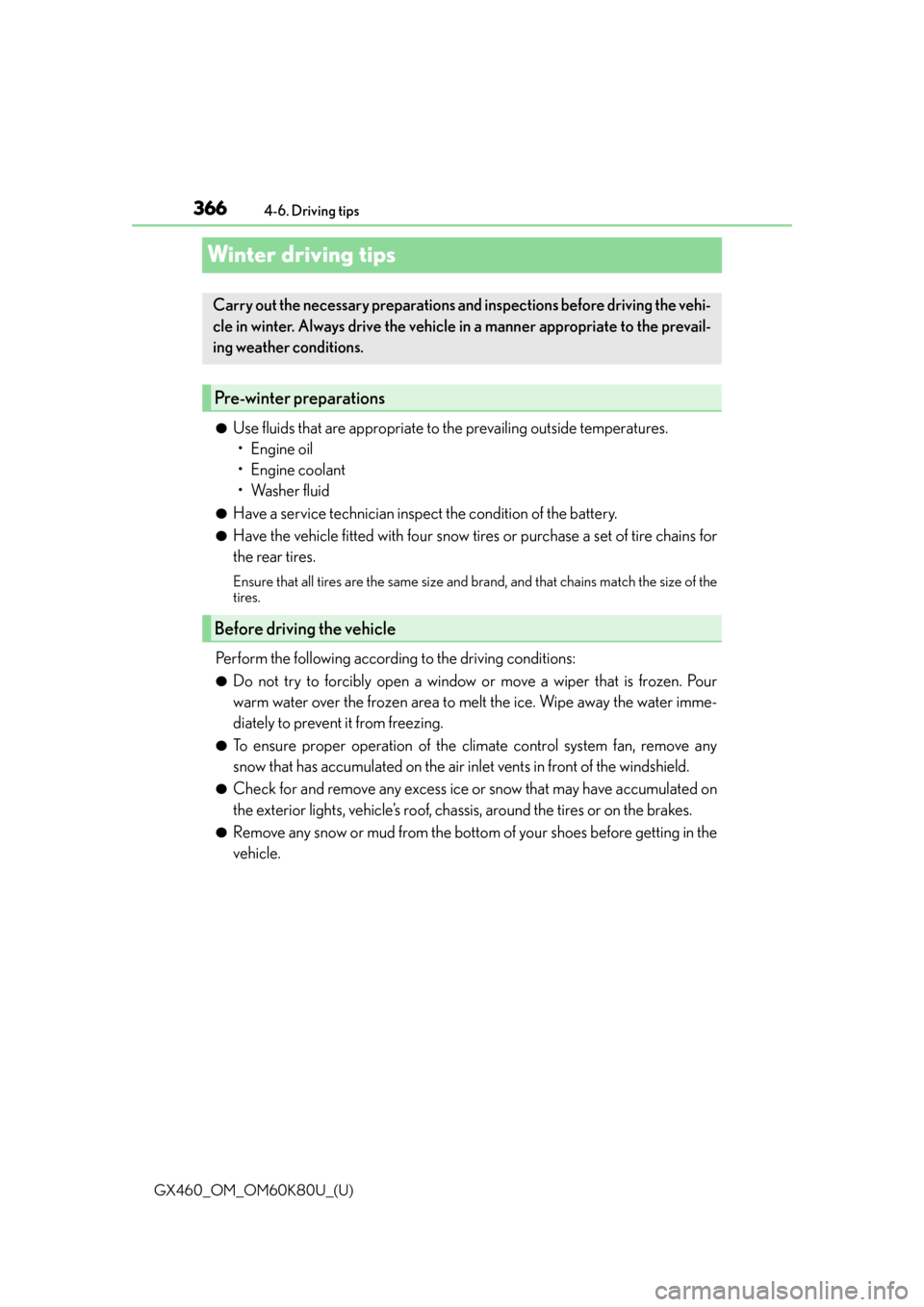brake Lexus GX460 2014 Using the air conditioning system and defogger / LEXUS 2014 GX460 (OM60K80U) Workshop Manual
[x] Cancel search | Manufacturer: LEXUS, Model Year: 2014, Model line: GX460, Model: Lexus GX460 2014Pages: 622, PDF Size: 8.61 MB
Page 342 of 622

342
GX460_OM_OM60K80U_(U)4-5. Using the driving support systems
◆Active TRAC (Traction Control) for L4 position*
Helps to maintain drive power and prevent
the 4 wheels from spinning when starting
the vehicle or accelerating on slippery roads, or in off-road conditions
◆Hill-start assist control (if equipped)
Helps to prevent the vehicle from rolling backward when starting on an incline or slip-
pery slope
◆KDSS (Kinetic Dynamic Suspension System)
KDSS helps to enhance ride comfort and handling response by using a hydraulic con-
trol system to control the suspension stabiliz er bars in response to road surface and
driving conditions during cornering or off-road driving
◆PCS (Pre-Collision system) (if equipped)
P. 3 5 7
◆Trailer Sway Control
Helps the driver to control trailer sway by selectively applying brake pressure for indi-
vidual wheels and reducing engine to rque when trailer sway is detected.
Trailer Sway Control is part of the VSC system and will not operate if VSC turned off
or experiences a malfunction.
*: The function only works in vehicles with Multi-terrain Select when Multi-terrain
Select is switched on
If the vehicle is in danger of slipping or
rolling backward when starting on an
incline, or if any of the drive wheels
spins, the slip indicator light flashes to
indicate that the TRAC or Active
TRAC/VSC/Trailer Sway Control/hill-
start assist control systems are operat-
ing.
A buzzer (intermittent) sounds to indicate that VSC is operating.
The stop lights and high mounted stoplight tu rn on when the hill-start assist control
system is operating.
When the TRAC or Active TRAC/VSC /Trailer Sway Control/hill-start
assist control systems are operating
Page 343 of 622

GX460_OM_OM60K80U_(U)
3434-5. Using the driving support systems
4
Driving
If the vehicle gets stuck in fresh snow or mud, the TRAC or Active TRAC/VSC/
Trailer Sway Control systems may reduce power from the engine to the wheels.
You may need to turn the system off to enable you to rock the vehicle in order to
free it.
■Turning off TRAC or Active TRAC system only
To turn the TRAC or Active TRAC
system off, quickly press and release
the switch.
The “TRAC OFF” will be shown on
the multi-information display.
Press the switch again to turn the sys-
tem back on.
■Turning off both TRAC or Active TRAC and VSC/Trailer Sway Control sys-
tems
To turn the TRAC or Active TRAC
and VSC/Trailer Sway Control sys-
tems off, press and hold the switch
for 3 seconds and more while the
vehicle is stopped.
The VSC OFF indicator light will
come on and the “TRAC OFF” will
be shown on the multi- information
display.
Press the switch again to turn the sys-
tem back on.
■When the “TRAC OFF” is displayed on the multi-information display even if the VSC
OFF switch has not been pressed
TRAC/Active TRAC, hill-start assist control, downhill assist control and Crawl Control
cannot be operated. Contact your Lexus dealer.
■Hill-start assist control operation conditions
●The shift lever is in D or S.
●The brake pedal is not depressed.
Disabling the TRAC or Active TRAC/VSC/Trailer Sway Control sys-
tems
Page 344 of 622

344
GX460_OM_OM60K80U_(U)4-5. Using the driving support systems
■Sounds and vibrations caused by the ABS/Multi Terrain ABS, brake assist, TRAC/
Active TRAC, VSC/Trailer Sway Control
and hill-start assist control systems
●A sound may be heard from the engine compartment when the engine is started or just
after the vehicle begins to move. This sound does not indicate that a malfunction has
occurred in any of these systems.
●Any of the following conditions may occur when the above systems are operating.
None of these indicates that a malfunction has occurred.
• Vibrations may be felt through the vehicle body and steering.
• A motor sound may be heard after the vehicle comes to a stop.
• The brake pedal may pulsate slightly afte r the ABS/Multi Terrain ABS is activated.
• The brake pedal may move down slightly after the ABS/Multi Terrain ABS is acti- vated.
■Reactivation of the TRAC or Active TRAC/VSC/Trailer Sway Control systems after
turning off the engine
Turning off the engine after turning off the TRAC or Active TRAC/VSC/Trailer Sway
Control systems will automatically re-enabled them.
■Reactivation of the TRAC or Active TRAC system linked to vehicle speed
When only the TRAC or Active TRAC system is turned off, the TRAC or Active TRAC
system will turn on when vehicle speed increases. However, when both TRAC or Active
TRAC and VSC/Trailer Sway Control systems are turned off, the systems will not turn on
even when vehicle speed increases.
■When the brake system operates continuously
The brake actuator may overheat. In this case, the TRAC or Active TRAC and hill-start
assist control systems will stop operating, a buzzer will sound and the “TRAC OFF” will
be shown on the multi-information display. Refrain from using the system until the mes-
sage goes off. (There is no proble m with continuing normal driving.)
■If the slip indicator comes on...
It may indicate a malfunction in the TRAC /Active TRAC, VSC/Trailer Sway Control or
hill-start assist control system. Consult your Lexus dealer.
Page 346 of 622

346
GX460_OM_OM60K80U_(U)4-5. Using the driving support systems
CAUTION
■Trailer Sway Control precaution
The Trailer Sway Control system is not able to reduce trailer sway in all situations.
Depending on many factors such as the condit
ions of the vehicle, trailer, road surface,
and driving environment, the Trailer Sway Co ntrol system may not be effective. Refer to
your trailer owner’s manual for information on how to tow your trailer properly.
■If trailer sway occurs
Observe the following precautions.
Failing to do so may caus e death or serious injury.
●Firmly grip the steering wh eel. Steer straight ahead.
Do not try to control trailer swaying by turning the steering wheel.
●Begin releasing the accelera tor pedal immediately but very gradually to reduce
speed.
Do not increase speed. Do not apply vehicle brakes.
If you make no extreme correction with the steering or brakes, your vehicle and trailer
should stabilize. ( P. 1 76 )
Page 357 of 622

357
GX460_OM_OM60K80U_(U)4-5. Using the driving support systems
4
Driving
PCS (Pre-Collision system)
◆Pre-collision seat belts (front seat belts only)
If the system detects that a collision is
unavoidable, the system will retract the
seat belt before the collision occurs.
The same will happen if the driver makes an emergency braking or loses con-
trol of the vehicle. ( P. 2 9 )
However, when the VSC system is disabled, the system will not operate in the
event of skidding.
◆Pre-collision brake assist
When there is a high possibility of a frontal collision, the system applies
greater braking force in relation to ho w strongly the brake pedal is depressed.
◆Pre-collision braking
When there is a high possibility of a frontal collision, the system warns the
driver using a warning light, warning di splay and buzzer. If the system deter-
mines that a collision is unavoidable, the brakes are automatically applied to
reduce the collision speed. Pre-collisio n braking can be disabled using the
pre-collision braking off switch.
◆AVS (Adaptive Variable Suspension System) control (if equipped)
When the system determines that there is a high possibility of a frontal colli-
sion, the AVS optimizes the damping effect ( P. 3 3 1 )
: If equipped
When the radar sensor detects possibility of a frontal collision, the pre-colli-
sion system such as the brakes and seat belts are automatically engaged to
lessen impact as well as vehicle damage.
Page 360 of 622

360
GX460_OM_OM60K80U_(U)4-5. Using the driving support systems
■The pre-collision system is operational when
●Pre-collision seat belts (situation 1):
• Vehicle speed is greater
than about 4 mph (5 km/h).
• The speed at which your vehicle is approaching the obstacle or the vehicle running ahead of you is greater than about 19 mph (30 km/h).
• The front occupants are wearing a seat belt.
●Pre-collision seat belts (situation 2):
• Vehicle speed is greater than about 19 mph (30 km/h).
• The system detects sudden braking or skidding.
• The front occupants are wearing a seat belt.
●Pre-collision brake assist:
• Vehicle speed is greater than about 19 mph (30 km/h).
• The speed at which your vehicle is approaching the obstacle or the vehicle running ahead of you is greater than about 19 mph (30 km/h).
• The brake pedal is depressed.
●Pre-collision braking:
• The pre-collision braking off switch is not pressed.
• Vehicle speed is greater th an about 10 mph (15 km/h).
• The speed at which your vehicle is approaching the obstacle or the vehicle running
ahead of you is greater than about 10 mph (15 km/h).
●AVS (Adaptive Variable Suspension System) control (if equipped):
• Vehicle speed is greater than about 4 mph (5 km/h).
• The speed at which your vehicle is approaching the obstacle or the vehicle running ahead of you is greater than about 19 mph (30 km/h).
●Pre-collision alert braking (vehicles with driver monitor system):
• The system determines that th e driver is not facing forward.
• The speed at which your vehicle is approaching the vehicle running ahead of you is greater than about 25 mph (40 km/h).
• Vehicle speed is greater than about 25 mph (40 km/h).
• The pre-collision braking off switch is not pressed.
• The steering is not being turned.
■Situations in which the pre-collision system does not function properly
The system may not function effectively in situations such as the following:
●On roads with sharp bends or uneven surfaces
●If a vehicle suddenly moves in front of your vehicle, such as at an intersection
●If a vehicle suddenly cuts in front of your vehicle, such as when overtaking
●In inclement weather such as heav y rain, fog, snow or sand storms
●When your vehicle is skidding with the VSC system off
●When an extreme change in vehicle height occurs
●When the axis of the radar is out of adjustment
Page 361 of 622

GX460_OM_OM60K80U_(U)
3614-5. Using the driving support systems
4
Driving
■Automatic cancelation of pre-collision system
When a malfunction occurs due to sensor contaminations, etc. that results in the sensors
being unable to detect obstacles, the pre-collision syst em will be automatically disabled.
In this case, the system will not activate even if there is a collision possibility.
■Obstacles not detected
The system cannot detect plastic obstacles su ch as pylons. There may also be occasions
when the system cannot detect pedestrians, animals, bicycles, motorcycles, trees, or
snowdrifts.
■Conditions that may trigger the system even if there is no possibility of a collision
●When there is an object by the roadside at the entrance to a curve
●When passing an oncoming vehicle on a curve
●When driving over a narrow iron bridge
●When there is a metal object on the road surface
●When driving on an uneven road surface (nose up, nose down)
●When passing an oncoming vehicle on a left turn
●When your vehicle rapidly closes on the vehicle in front
●When a grade separation/interchange, sign, billboard, or other structure appears to be
directly in the vehicle’s line of travel
●When a billboard or other metallic structure appears to be in the direct line of travel
due to driving on a hill
●When there are excessive changes in the vehicl e height (when it tilts forwards or back-
wards)
●When the axis of the radar is out of adjustment
●When passing through certain toll gates
●When passing through an overpass
●When passing through a tunnel
When the system is activated in the situations described above, there is also a possibility
that the seat belts will retrac t quickly and the brakes will be applied with a force greater
than normal. When the seat belt is locked in the restricted position, stop the vehicle in a
safe place, release the seat belt and refasten it.
■When there is a malfunction in the system, or if the system is temporarily unusable
Warning lights and/or warning mess ages will turn on or flash. (P. 5 0 7 , 5 1 4 )
Page 363 of 622

GX460_OM_OM60K80U_(U)
3634-5. Using the driving support systems
4
Driving
CAUTION
■Limitations of the pre-collision system
Do not overly rely on the pre-collision system. Always drive safely, taking care to
observe your surroundings and checking for any obstacles or other road hazards.
Failure to do so may cause an accident resulting in death or serious injury.
■Cautions regarding the assist contents of the system
By means of alarms and brake control, the pre-collision system is intended to assist the
driver in avoiding collisions through the process of LOOK-JUDGE-ACT. There are
limits to the degree of assistance the system can provide, so please keep in mind the
following important points.
●Assisting the driver in watching the road
The pre-collision system is only able to detect obstacles directly in front of the vehicle,
and only within a limited range. It is not a mechanism that allows careless or inatten-
tive driving, and it is not a system that can assist the driver in low-visibility conditions. It
is still necessary for the driver to pay cl ose attention to the vehicle’s surroundings.
●Assisting the driver in making correct judgment
When attempting to estimate the possibility of a collision, the only data available to
the pre-collision system is that from obstacle s it has detected directly in front of the
vehicle. Therefore, it is absolutely necess ary for the driver to remain vigilant and to
determine whether or not there is a possib ility of collision in any given situation.
●Assisting the driver in taking action
The pre-collision system’s braking assist feat ure is designed to help reduce the sever-
ity of a collision, and so only acts when the system has judged that a collision is
unavoidable. This system by itself is not capable of automatically avoiding a collision
or bringing the vehicle to a stop safety. Fo r this reason, when encountering a danger-
ous situation the driver must take direct and immediate action in order to ensure the
safety of all involved.
Page 364 of 622

364
GX460_OM_OM60K80U_(U)4-5. Using the driving support systems
CAUTION
■When the sensor may not be correctly detecting the vehicle ahead
Apply the brakes as necessary in any of the following situations.
●When water or snow thrown up by the surrounding vehicles hinders the functioning
of the sensor
●When your vehicle is pointing upwards (caused by a heavy load in the luggage com-
partment etc.)
●Vehicles that cut in suddenly
●Vehicles with small rear ends (tra
ilers with no load on board etc.)
●Motorcycles traveling in the same lane
■Handling the radar sensor
Observe the following to ensure the pre-collision system can function effectively:
●Keep the sensor and front grille cover clean at all times.
Clean the sensor and front grille cover with a soft cloth so you do not mark or dam-
age them.
●Do not subject the sensor or surrounding area to a strong impact.
If the sensor moves even slightly off posi tion, the system may become inaccurate or
malfunction. If the sensor or surrounding area is subject to a strong impact, always
have the area inspected and adjusted by your Lexus dealer.
●Do not disassemble the sensor.
●Do not attach accessories or stickers to the sensor, grille cover or surrounding area.
●Do not modify or paint the sensor and grille cover.
Page 366 of 622

366
GX460_OM_OM60K80U_(U)4-6. Driving tips
Winter driving tips
●Use fluids that are appropriate to the prevailing outside temperatures.
•Engine oil
• Engine coolant
• Washer fluid
●Have a service technician inspect the condition of the battery.
●Have the vehicle fitted with four snow tires or purchase a set of tire chains for
the rear tires.
Ensure that all tires are the same size and br and, and that chains match the size of the
tires.
Perform the following according to the driving conditions:
●Do not try to forcibly open a window or move a wiper that is frozen. Pour
warm water over the frozen area to melt the ice. Wipe away the water imme-
diately to prevent it from freezing.
●To ensure proper operation of the climate control system fan, remove any
snow that has accumulated on the air in let vents in front of the windshield.
●Check for and remove any excess ice or snow that may have accumulated on
the exterior lights, vehicle’s roof, chassis, around the tires or on the brakes.
●Remove any snow or mud from the bottom of your shoes before getting in the
vehicle.
Carry out the necessary preparations and inspections before driving the vehi-
cle in winter. Always drive the vehicle in a manner appropriate to the prevail-
ing weather conditions.
Pre-winter preparations
Before driving the vehicle